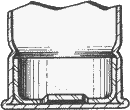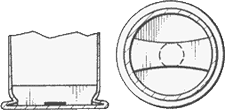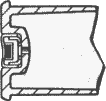Home | Glossary | Resources | Help | Contact Us | Course Map
Archival Notice
This is an archive page that is no longer being updated. It may contain outdated information and links may no longer function as originally intended.
Cartridge Cases
The modern cartridge case serves several important functions:
- Contains the other components (projectile, primer, propellant) in a single unit for convenience of handling and loading
- Resists the firing-pin blow during ignition
- Forms a gas seal (obturation)
In the earliest days of small arms, cartridges began to evolve as an alternative to the slower process of handling a powder flask for charging each shot. In a rudimentary cartridge, a charge of black powder was measured into a thin paper or linen tube that was slightly smaller than the bore. A ball was then placed on top of the powder in the tube and secured with glue or a string.
Early breechloaders incorporated a sharpened cutter blade atop the breechblock. A paper cartridge was loaded, but when properly seated, stood slightly out of the barrel. When the shooter closed the action, the cutter sheared off the rear of the cartridge, exposing propellant to the flash hole. This eliminated misfires caused by excess paper blocking the flame from the percussion cap.
The Burnside rifle used an unusual brass cartridge that was largely supported by the breech rather than the barrel. A small covered hole in the base of the cartridge received the blast from the percussion cap; the seal burned through, igniting the powder charge. The Burnside cartridge walls were stiff and did not expand sufficiently to seal the bore.
The true modern cartridge is flexible enough to expand under pressure and completely seal the rear of the barrel, yet strong enough to remain intact at peak operating pressure. Its diameter must be slightly smaller than that of the chamber to keep the cartridge case wall expansion to a minimum. The length dimensions have to match the chambers corresponding support surfaces so that the case can withstand the blow of the guns firing pin.
Early Metallic
The French gunmaker Louis Nicolas Auguste Flobert developed target arms and low-powered cartridges. The ball was loaded in a thin copper case with a hollow rim folded into the base. Fulminate was smeared into the hollow rim, providing all of the power for the ball; no additional propellant was used. The firing pin struck the rim against the rear face of the barrel, igniting the fulminate. This cartridge class is known as rimfire. Smith & Wesson made improvements to the basic Flobert concept, enhancing reliability and power. These improvements were introduced in 1857 with the 22 Short cartridges. Today's 22 Short cartridges are practically indistinguishable in form from the original Smith & Wesson version.
Another cartridge system once popular in Europe was pinfire ignition. A small pocket of fulminate was placed on the sidewall of a copper case. A brass pin was installed in the opposite side of the case; the internal tip of the pin rested on the fulminate. The hammer was unusual in that it fell on the side of the case, driving the pin into the fulminate. This system was not as robust as the rimfire system because the gun chamber must be slotted for the pins, and the ammunition manufacturing cost was greater.
Other early cartridges combined the required components, yet failed to meet the sealing requirement. Needle-fire systems placed the primer in the base of the bullet. A long, sharp firing pin pierced the paper or foil case to reach the primer. The French Chassepot and German Dreyse service rifles were the first successful newly manufactured breechloaders (i.e., not converted from muzzleloaders) in general military issue. Ultimately, other cartridges providing a better gas seal were developed.
The Volcanic cartridge/firearm system made by Robbins & Lawrence around 1854 provides an example of an early innovation from the United States. For all practical purposes, the cartridge was a Mini ball with its base cavity filled with propellant. A paper disc holding a fulminate pellet closed off the back. It was similar in concept to needle-fire but did not require the long and easily damaged firing pin. The cartridges were underpowered and the gas seal was inefficient, but the Volcanic repeating rifle could hold a large quantity of ammunition.
The legacy of the Volcanic ammunition is practically nonexistent, but the legacy of the Volcanic rifle action is significant in firearms technology. Oliver Winchester and B. Tyler Henry used it as the starting point for the famous Winchester line of lever-action repeating rifles.
Rimfire
Rimfire ignition began to supplant other American cartridge concepts by the time of the Civil War because of its simplicity of design and manufacture. Some officers carried Smith & Wesson .22 and .32 caliber rimfire revolvers as secondary arms. A few Union units armed themselves with Henrys repeater (firing a .44 caliber rimfire cartridge) or the fast-loading Spencer repeating rifle (firing bullets of up to .55 caliber). Although not as powerful as the .58 caliber muzzleloaders carried by both Union and Confederate soldiers, the fast-firing Henrys and Spencers could produce a large volume of fire.
As percussion breechloaders were converted to accept true cartridges, those cartridges were mostly rimfire. The U.S. military issued rimfire cartridges as large as .58 caliber. However, there was room for improvement.
Early rimfire cartridges were prone to misfires. The priming compound was essentially glued into the rim cavity with organic binders. The only mechanical positioning came from the pressure of the powder charge against the fulminate. If handled roughly, a piece of the fulminate could fall out of the rim cavity, leaving a void and the potential for misfire. Another rimfire problem was that most cartridges were limited in power by the necessarily thin case. Thickening the case to handle more pressure also thickened the rim, causing misfires.
Centerfire
Development focused on placing the pellet of fulminate so that it was better retained. Most design work placed the pellet in the center of the cartridge base. This cartridge class was known at the time as centrally primed or centralfire; today known as centerfire. Once again, the interdependence of gun and ammunition design and development came into play; firing pins of rimfire firearms had to be moved to strike the center of the case rather than the rim.
There is a broad range of early centerfire priming systems, many originating in military arsenals. Those classified as internally primed looked like rimfire cartridges when viewed from the base. These have a separate metal structure carrying the priming pellet, which is pushed from the inside to the cases base and crimped in place prior to charging with propellant. There is no evidence of the primer in the physical appearance of the cartridge. Two such designs used by U.S. arsenals in the post-Civil War period were the Benet system and the Martin bar anvil system. Benet-primed ammunition was standard issue for U.S. military rifles and revolvers through the late 1870s.
Despite the initial success of the internally primed cartridge, development continued. Central priming still required a thin and flexible case to allow the firing pin blow to effectively transmit energy to the internally mounted fulminate pellet. The solution required a stronger cartridge case, while retaining thin metal over the priming pellet. This was accomplished by separating the case from the primer.
Primer Pocket/Folded Head
Based on design experiments by Col. Hiram Berdan, the folded-head case was developed.
A central pocket for a separate primer and an anvil surface were produced to provide the pinch point that activated the priming compound when the firing pin struck the primer. One to three holes were pierced or drilled around the anvil to allow fire from the primer to reach the main charge. Other than the dimensions, the primer was similar to the familiar percussion cap of the muzzleloading era.
The folded-head case had a weakness; the fold that produced the rim stressed the metal. Over time, the stressed area became brittle, causing the case to fail at the fold. The metallurgical knowledge to properly relieve the stress in this area was in early stages of development; some batches of cases were loaded and issued with brittle rims.
Balloon-Head
The next evolutionary step was the modern case. The rim of the balloon-head case was forged, rather than folded. It was stronger than the folded-head case and allowed the primer pocket to balloon into the powder space. This design gave the internal volume required for black powder. The rim cavity and the need for the high-stress fold at a critical point were eliminated. The head could fail when the case was very old, but critical rim blowouts were prevented. The balloon-head case continued to be used in some North American ammunition through the 1960s, typically in low-pressure revolver cartridges.
As smokeless propellants were developed, the volume issue was less important; the case could be further strengthened by filling in the area surrounding the primer pocket. This minor improvement (that began in high-pressure cases in the late 19th Century) is now commonplace in military and sporting cartridge cases. This modern design is called the solid-head case. When the balloon-head case was first developed, some ammunition companies referred to it as a solid-head case to emphasize the strength improvement over folded-head construction. Balloon-head is a modern term, coined to separate the current solid-head case from its immediate predecessor.
Modern Developments
Today, variation in cartridge case construction is seen only in the primer pocket. An English development, Boxer priming, placed the anvil in the primer as a separate part. The primer pocket has a single, large flash hole on the case centerline. The American development, Berdan priming, makes the anvil an integral part of the case and has one to three small flash holes positioned around the anvil.
For most purposes, the type of priming system is transparent to the end user. However, Boxer priming has an advantage to those who prefer to recycle the case by reloading. The centrally placed flash hole in the Boxer system allows the spent primer to be removed with a thin punch tool and a new primer inserted. Ironically, most of the world adopted the American Berdan system while America adopted the English Boxer system.
Over the years, cartridge cases have been manufactured using a variety of materials. Although aluminum has been growing in popularity, brass, specifically cartridge brass, (70 percent copper/30 percent zinc) is most common in Western European and American sporting ammunition. Mild steel (steel with low carbon content) has been used where iron is a more abundant resource than copper. Both steel and brass have similar abilities to withstand pressure.
Ammunition for modern shotguns uses a hybrid cartridge case with the following features:
- Body made of paper or flexible plastic
- A plastic or composition base wad around the primer
- A thin metal base section that provides adequate grip for the extractor and support for the primer
In the past, all-brass shotshells were used and are still seen today in some sports; the hybrid case represents the majority of shotshells produced and fired.
Additional Online Courses
- What Every First Responding Officer Should Know About DNA Evidence
- Collecting DNA Evidence at Property Crime Scenes
- DNA – A Prosecutor’s Practice Notebook
- Crime Scene and DNA Basics
- Laboratory Safety Programs
- DNA Amplification
- Population Genetics and Statistics
- Non-STR DNA Markers: SNPs, Y-STRs, LCN and mtDNA
- Firearms Examiner Training
- Forensic DNA Education for Law Enforcement Decisionmakers
- What Every Investigator and Evidence Technician Should Know About DNA Evidence
- Principles of Forensic DNA for Officers of the Court
- Law 101: Legal Guide for the Forensic Expert
- Laboratory Orientation and Testing of Body Fluids and Tissues
- DNA Extraction and Quantitation
- STR Data Analysis and Interpretation
- Communication Skills, Report Writing, and Courtroom Testimony
- Español for Law Enforcement
- Amplified DNA Product Separation for Forensic Analysts














